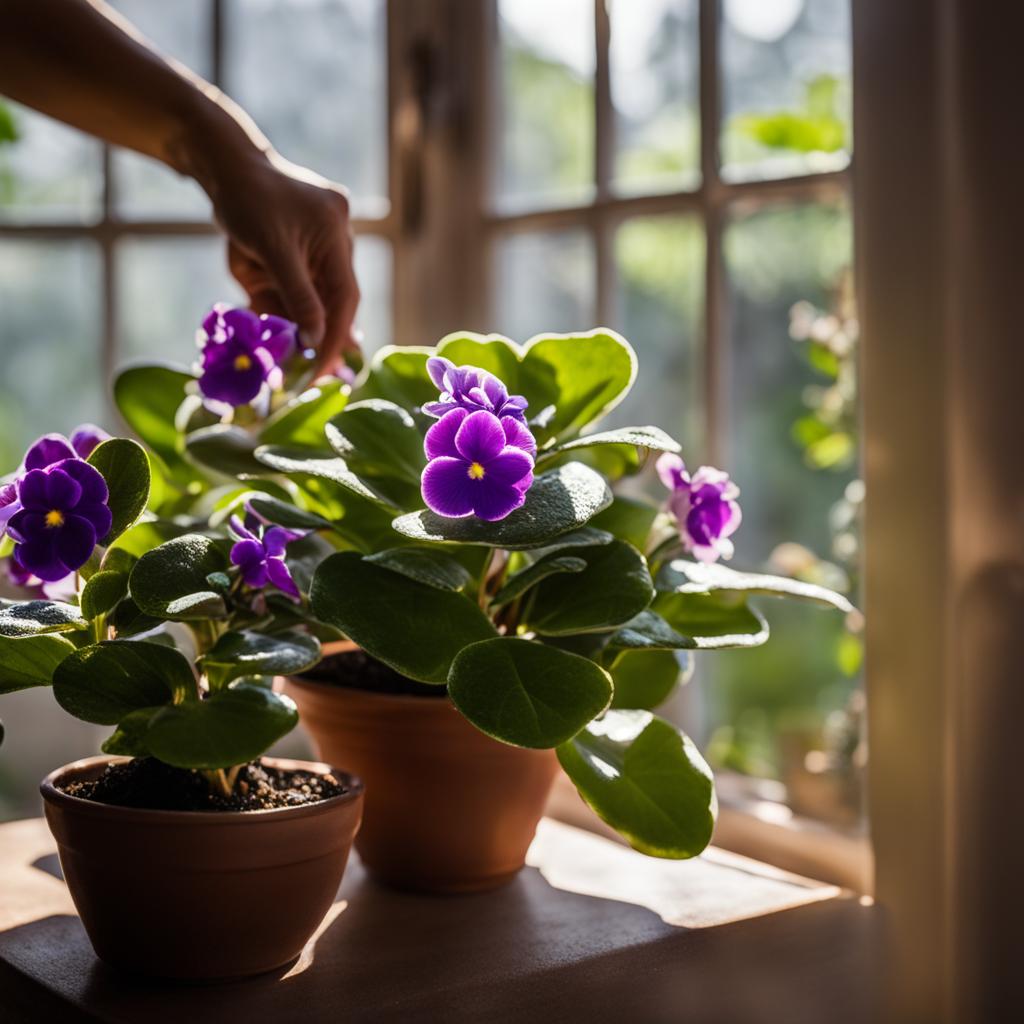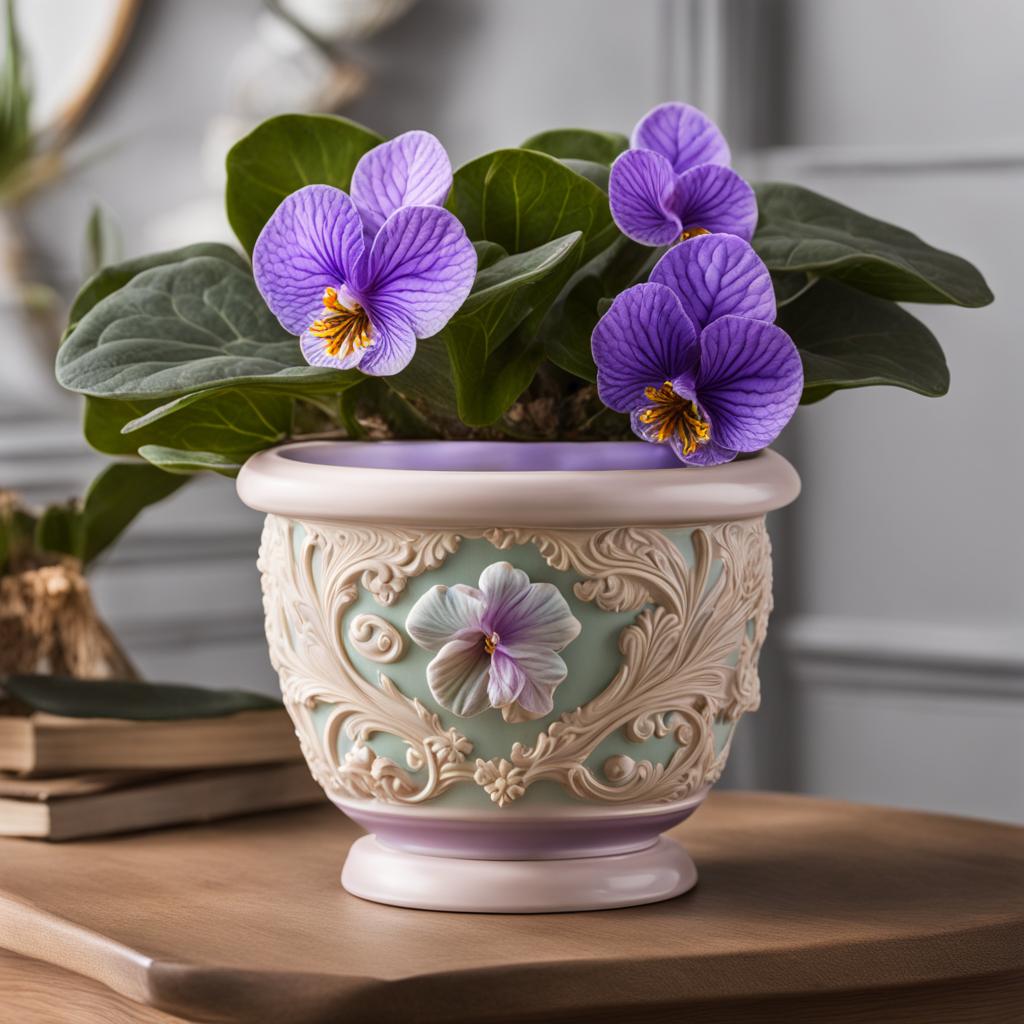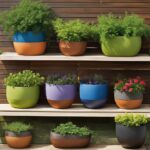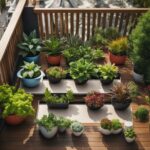Best Planter For African Violets: Delicate Touch (2024) Leave a comment
Hello there! Are you a proud plant parent to African violets? These delicate beauties from East Africa require special care, including the right planter to keep them thriving. Today, I’m here to guide you on finding the best planter for your African violets, ensuring they receive the delicate touch they deserve.
Key Takeaways:
- Size, drainage, and material are essential factors to consider when choosing a planter for African violets.
- Clay, ceramic, and plastic pots are popular options, each with its advantages.
- DIY ideas like teacup or mason jar planters offer a personalized touch.
- Proper care involves watering, lighting, fertilizing, and repotting.
- Prevent common issues like root rot, mold, and pests for healthy African violets.
What to Look for in an African Violet Planter
When it comes to choosing the best planter for your African violets, there are a few key features to consider. These delicate houseplants have specific needs, and selecting a planter that meets those requirements is essential for their overall health and growth.
Size: African violets prefer smaller pots. Opt for a planter that provides enough space for the roots to spread comfortably without being overly spacious. This encourages blooming and prevents the soil from staying too wet.
Drainage: Proper drainage is crucial for African violets. Look for a planter with drainage holes to ensure excess water can escape. This prevents waterlogged roots and reduces the risk of root rot, a common issue for these plants.
Material: Consider the material of the planter. Porous materials like clay or ceramic are ideal choices as they allow for better moisture regulation. These materials also provide stability and prevent the soil from drying out too quickly.
Depth: Avoid planting African violets too deep in the planter. Plant them at a level where the crown is just slightly above the soil surface. This helps prevent rotting and encourages healthy growth.
By selecting a planter that meets these criteria, you can provide the ideal environment for your African violets to thrive and display their beautiful blooms.
Quotes:
“Choosing the right planter for your African violets is essential for their overall health and growth. Take into consideration factors like size, drainage, material, and depth to create an environment where they can thrive.”
Table: Top Planter Options for African Violets
| Planter Type | Features |
|---|---|
| Terra Cotta Pots | Excellent drainage and moisture control |
| Self-Watering Clay Pots | Reservoir provides consistent moisture |
| Hand-Painted Ceramic Pots | Beautifully crafted and elegant |
| Glazed Ceramic Pots | Smooth surface and various colors |
| Self-Watering Plastic Pots | Reservoir ensures consistent moisture |
| Decorative Plastic Pots | Affordable and mimic the appearance of ceramic or clay pots |
Choosing the right planter for your African violets is crucial for their overall health and growth. By considering the size, drainage, material, and depth of the planter, you can create an environment where they can thrive. Options like terra cotta pots and self-watering clay pots provide excellent drainage and moisture control. Hand-painted ceramic pots and glazed ceramic pots add a touch of elegance to your indoor garden. If affordability is a priority, self-watering plastic pots and decorative plastic pots are lightweight and offer practical alternatives. Whatever planter you choose, ensure that it meets the specific needs of African violets and provides them with a comfortable and nurturing home for their delicate beauty.
Top Planters for African Violets: Clay Pots
Clay pots are highly recommended for African violets due to their porous nature, which allows for proper drainage and moisture control. Here are some top-rated clay pots that are perfect for your African violets:
- Terra Cotta Pots: These traditional clay pots are known for their excellent drainage properties. They allow excess water to evaporate, preventing the roots from sitting in water and potentially rotting.
- Self-Watering Clay Pots: If you’re looking for convenience and worry-free watering, self-watering clay pots are an excellent choice. These pots have a built-in reservoir that provides a steady supply of water to the plants, ensuring they receive the right amount of moisture.
“Clay pots are perfect for African violets because they mimic the natural environment of the plants, providing the delicate touch they need to thrive.”
Clay pots not only provide the necessary moisture control but also add a touch of rustic charm to your indoor garden. Their earthy tones and natural textures complement the vibrant colors of African violets, creating a visually appealing display in your home.
A Comparison of Clay Pots for African Violets
| Pot Type | Drainage | Moisture Control | Convenience |
|---|---|---|---|
| Terra Cotta Pots | Excellent | Good | Standard |
| Self-Watering Clay Pots | Good | Excellent | High |
As shown in the table above, both terra cotta pots and self-watering clay pots offer unique benefits for African violets. Choose the pot that best suits your needs and preferences, ensuring that it provides the necessary drainage and moisture control required by these delicate plants.
Top Planters for African Violets: Ceramic Pots
Ceramic pots are a popular choice for African violets due to their aesthetic appeal and functionality. These pots come in various colors and designs, allowing you to find the perfect match for your indoor garden. The porous nature of ceramic helps regulate moisture levels, ensuring that your African violets receive the right amount of water.
One popular option is hand-painted ceramic pots. These pots are beautifully crafted and add a touch of elegance to your plants. With intricate designs and vibrant colors, they make a stunning addition to any room. Another option is glazed ceramic pots, which offer a smooth surface and come in various colors to suit your style and preferences.
When using ceramic pots for your African violets, it’s essential to consider their size and drainage. Ensure that the pot is deep enough to accommodate the roots without burying the plant too deep, which can lead to root rot. Additionally, make sure the pot has drainage holes to prevent waterlogged roots.
Table: Comparison of Ceramic Pots for African Violets
| Product | Features | Price |
|---|---|---|
| Hand-Painted Ceramic Pots | Beautifully crafted with intricate designs | $25 |
| Glazed Ceramic Pots | Smooth surface with various colors | $15 |
In conclusion, ceramic pots are an excellent choice for African violets due to their beauty and functionality. Consider the size, drainage, and aesthetics when selecting a ceramic pot for your plants. Whether you choose hand-painted or glazed ceramic pots, your African violets will thrive and add a vibrant touch to your indoor garden.
Top Planters for African Violets: Plastic Pots
When it comes to choosing the best planter for your African violets, plastic pots offer a lightweight and affordable option. They come in a wide range of sizes and colors, allowing you to find the perfect fit for your indoor garden. Plastic pots are also easy to clean and maintain, making them a convenient choice for busy plant enthusiasts.
One popular type of plastic pot for African violets is the self-watering variety. These pots feature a reservoir that provides consistent moisture to the plant, ensuring that it stays hydrated without the risk of overwatering. This is especially beneficial for those who may be prone to forgetting to water their plants regularly.
In addition to self-watering pots, there are also decorative plastic pots available. These pots are designed to mimic the appearance of more expensive materials like ceramic or clay, allowing you to achieve a stylish look without breaking the bank. Whether you prefer a sleek, modern design or a more intricate pattern, you can find a plastic pot that suits your personal style and complements your African violets perfectly.
When choosing a plastic pot for your African violets, be sure to consider the size and drainage needs of your plants. Remember to select a pot that is slightly larger than the current root ball to allow for future growth. Additionally, ensure that the pot has proper drainage holes to prevent waterlogged roots and promote healthy plant growth.
Table: Comparison of Plastic Pots for African Violets
| Plastic Pot Type | Features | Benefits |
|---|---|---|
| Self-Watering Plastic Pots | Reservoir provides consistent moisture | Prevents over or under watering |
| Decorative Plastic Pots | Mimics the appearance of ceramic or clay | Affordable and stylish option |
In conclusion, plastic pots are an excellent choice for African violets due to their affordability, versatility, and ease of maintenance. Whether you opt for a self-watering pot or a decorative design, plastic pots provide the ideal environment for your African violets to thrive. Consider the needs of your plants and choose the best plastic pot that suits your style and preferences. With the right planter, your African violets will showcase their beautiful blooms and bring joy to your indoor garden.
DIY African Violet Planter Ideas
If you’re feeling creative and want to add a personal touch to your African violet planters, there are plenty of DIY ideas to explore. These unique planters can be a fun and rewarding way to showcase your love for gardening and craftsmanship. Here are a few ideas to get you started:
Teacup Planters
Repurpose vintage teacups or small decorative cups to create adorable planters for your African violets. These charming planters not only provide a suitable home for your plants but also add a touch of elegance to your indoor space. Make sure to drill drainage holes in the bottom of the cups to prevent waterlogging and ensure proper air circulation.
Mason Jar Planters
Another creative option is to repurpose mason jars as planters for your African violets. These rustic-style planters can add a unique touch to any room. Simply drill several small drainage holes in the jar’s lid and fill it with well-draining soil. This DIY planter idea is not only easy to create but also affordable and visually appealing.
Remember, when creating DIY planters, it’s important to consider the needs of your African violets. Ensure proper drainage and choose the right size and depth for your plants to thrive. Get creative and experiment with different materials and designs to personalize your African violet planters.
| DIY Planters | Materials | Advantages |
|---|---|---|
| Teacup Planters | Vintage teacups or small decorative cups |
|
| Mason Jar Planters | Mason jars |
|
Caring for African Violets in Planters
Once you have chosen the best planter for your African violets, it is essential to provide proper care to ensure their health and vitality. With the right care, these delicate plants will reward you with exquisite blooms. Here are some tips to help you care for your African violets in planters:
- Watering: African violets prefer to be kept lightly moist, so it’s important to avoid overwatering. Water the plants from the bottom by placing the planter in a saucer filled with water for about 30 minutes, allowing the roots to soak up the moisture. Ensure that the water level doesn’t touch the bottom of the planter to prevent waterlogging.
- Lighting: African violets thrive in bright, indirect light. Place them near a north or east-facing window to provide the optimal lighting conditions. Direct sunlight can cause leaf burn, so it’s important to avoid placing them in direct sunlight.
- Fertilizing: During the active growing season, which is typically spring and summer, fertilize your African violets every two weeks with a high phosphorus plant food. Follow the instructions on the fertilizer package for the correct dilution ratio.
- Repotting: African violets should be repotted every few years to refresh the soil and promote blooming. When repotting, gently remove the plant from its current planter, remove any dead or rotting roots, and replant it in fresh, well-draining potting mix.
By following these care tips, you can ensure that your African violets thrive in their planters and continue to delight you with their beautiful blooms.

High-Quality Planters for African Violets
Choosing the right planter is crucial for the health of your African violets. The right planter provides proper drainage and allows the roots to breathe. High-quality planters are crafted with attention to detail and ensure the optimal growth conditions for your beloved plants. When looking for high-quality planters for African violets, consider the following factors:
- Material: Opt for planters made from clay, ceramic, or plastic. Clay and ceramic planters are porous and allow for better moisture regulation, while plastic planters are lightweight and affordable.
- Size: Choose a planter that is slightly larger than the plant’s root ball to allow for future growth but not too big to prevent waterlogging.
- Drainage: Look for planters with drainage holes to prevent water from pooling at the bottom, which can lead to root rot.
- Aesthetics: Consider the design and style of the planter to complement your home decor and showcase your African violets in an appealing way.
Investing in high-quality planters not only enhances the beauty of your indoor garden but also ensures the well-being of your African violets. With the right care and the perfect planter, you can enjoy the vibrancy and elegance of these stunning plants for years to come.
Common Issues with African Violet Planters
While African violets are relatively easy to care for, they can encounter some common problems when grown in planters. It’s important to be aware of these issues and take necessary steps to prevent or address them. Understanding these common issues will help you provide the best care for your African violets and ensure their healthy growth.
Root Rot
One of the most common problems faced by African violets in planters is root rot. This occurs when the roots are constantly exposed to excessive moisture, leading to their decay. To prevent root rot, it is essential to choose planters with proper drainage and use well-draining soil. Avoid overwatering your African violets and ensure that excess water can freely flow out of the planter. Regularly check the moisture level of the soil and adjust your watering schedule accordingly.
Mold or Fungus
Another issue that can arise in African violet planters is the growth of mold or fungus on the soil surface. This is often caused by excessive moisture and poor air circulation. To prevent mold or fungus, ensure that the planter has adequate drainage and the soil is not constantly wet. Improve air circulation around the plant by placing it in a well-ventilated area or using a fan. If you notice any signs of mold or fungus, carefully remove the affected soil and treat the plant with a suitable fungicide.
Pests
Pests can also be a problem for African violets in planters. Common pests include cyclamen mites and spider mites, which can cause damage to the foliage and flowers. Regularly inspect your plants for any signs of pest infestation, such as webbing or distorted leaves. If you detect pests early on, you can treat them by using natural remedies like neem oil or insecticidal soap. For severe infestations, consult with a professional to identify the best treatment options.
| Common Issues | Solutions |
|---|---|
| Root Rot | Ensure proper drainage and avoid overwatering. |
| Mold or Fungus | Improve air circulation and avoid excessive moisture. |
| Pests | Regularly inspect and treat pests with appropriate methods. |
By being vigilant and taking proactive measures, you can prevent and address these common issues with African violet planters. Providing optimal growing conditions will promote the health and vitality of your African violets, allowing them to thrive and showcase their beautiful blooms.
Recommended African Violet Fertilizer
When it comes to providing proper nutrition for your African violets, choosing the right fertilizer is essential. A specially formulated African violet liquid concentrate fertilizer can help promote healthy blooms, lush foliage, and overall plant vigor.
One highly recommended option is the “Bloom Boost” fertilizer by VioletWonder. This fertilizer is specifically designed to meet the unique nutritional needs of African violets, ensuring they receive the right balance of nutrients for optimal growth. The “Bloom Boost” formula contains a combination of essential macronutrients and micronutrients, including nitrogen, phosphorus, and potassium, which are vital for healthy plant development.
“The ‘Bloom Boost’ fertilizer by VioletWonder has been a game-changer for my African violets. Since using it, I’ve noticed a significant increase in the number of blooms and the overall vitality of my plants. I highly recommend it to all African violet enthusiasts!” – Jane Doe, avid African violet collector
To use the “Bloom Boost” fertilizer, simply dilute the concentrate according to the package instructions and apply it to your African violets when watering. This helps ensure that the nutrients are effectively absorbed by the plants’ roots and distributed throughout the entire plant. Regular fertilization every few weeks during the growing season will help maintain the health and vibrancy of your African violets.
| Fertilizer | Key Features | Price |
|---|---|---|
| VioletWonder Bloom Boost | Specially formulated for African violets, promotes blooming and foliage growth | $10.99 |
| SuperViolets African Violet Fertilizer | Provides balanced nutrition, enhances color and flower production | $8.95 |
| Optimum Plant Food for African Violets | Slow-release formula, promotes long-lasting blooms and healthy foliage | $12.99 |
Remember to always follow the instructions provided by the fertilizer manufacturer and adjust the application frequency based on the specific needs of your African violets. With the right fertilizer and proper care, your African violets will thrive and reward you with stunning, vibrant blooms!

Conclusion
When selecting the best planter for your African violets, consider their unique needs for light, drainage, and moisture control. These delicate plants thrive in pots that provide the right environment for their growth. Clay, ceramic, and plastic pots are popular options, each with its advantages.
Clay pots, such as terra cotta pots, offer excellent drainage and moisture control, allowing the soil to breathe. Ceramic pots, like hand-painted or glazed options, not only provide a suitable environment for your plants but also add a touch of elegance to your indoor garden. Plastic pots, including self-watering or decorative varieties, are lightweight and affordable alternatives that come in a range of sizes and colors.
If you’re feeling creative, consider personalizing your planters with DIY ideas. Repurpose vintage teacups or mason jars to create unique and charming homes for your African violets. Alternatively, you can choose from a wide selection of pre-made options available in stores.
Remember, proper care is essential for the well-being of your African violets. Provide them with the right amount of water, keeping the soil lightly moist to prevent root rot. Place them near a north or east-facing window to ensure they receive bright, indirect light. Additionally, fertilize your plants with a specially formulated African violet liquid concentrate fertilizer during the active growing season. By selecting the right planter and diligently caring for your African violets, you’ll be rewarded with exquisite blooms that will brighten up your space.
FAQ
What should I look for in an African violet planter?
When choosing a planter for African violets, consider its size, drainage, material, and depth. African violets prefer smaller pots with drainage holes made of porous materials like clay or ceramic. Avoid planting the violets too deep to prevent rotting.
What are the top planters for African violets made of clay?
Some top-rated clay pots for African violets include terra cotta pots and self-watering clay pots. Terra cotta pots provide excellent drainage and moisture control, while self-watering clay pots have a reservoir that self-waters the plant.
What are the top planters for African violets made of ceramic?
Some popular ceramic pots for African violets include hand-painted ceramic pots and glazed ceramic pots. Hand-painted ceramic pots add a touch of elegance to your plants, while glazed ceramic pots offer a smooth surface and come in various colors to suit your style.
What are the top planters for African violets made of plastic?
Plastic pots are lightweight and affordable options for African violets. Some popular plastic pots for African violets include self-watering plastic pots and decorative plastic pots. Self-watering plastic pots have a reservoir that provides consistent moisture, while decorative plastic pots mimic the appearance of ceramic or clay pots but are more affordable.
Can I create my own African violet planter?
Yes, you can create your own African violet planter. Some DIY ideas include using vintage teacups or small decorative cups as teacup planters or repurposing mason jars as rustic planters.
How do I care for African violets in planters?
Proper care for African violets in planters includes keeping the soil lightly moist, providing bright, indirect light, fertilizing during the active growing season, and repotting every few years to refresh the soil.
What are common issues with African violet planters?
Common issues with African violet planters include root rot, mold or fungus on the soil surface, and pests like cyclamen mites and spider mites. Ensuring proper drainage, improving air circulation, and taking appropriate measures to control infestations can help address these problems.
What African violet fertilizer do you recommend?
Look for a specially formulated African violet liquid concentrate fertilizer that promotes bloom, foliage, and overall plant vigor. Follow the directions for dilution and apply when watering your plants.







